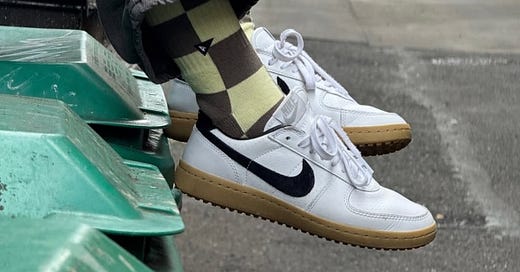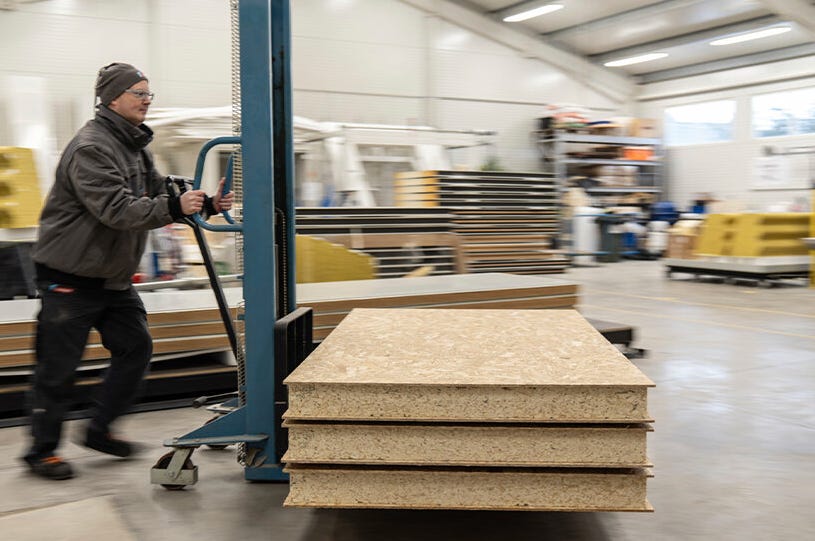🧦The Reality of Making Products in the U.S. vs. Overseas
More Trade Talk, PU waste to a new product, Is Made in America a Fashion Fantasy? ALD x TNF, Friend of the People SANGO, Arvin Goods...
Happy Sunday,
We’ve been talking a lot about trade lately, and it’s a conversation that will keep evolving as the new administration’s policies take shape. One thing is clear: they are pushing for more consumable goods to be re-shored to America. Whether or not that’s actually feasible is another discussion altogether.
Take a look at the Business of Fashion article we shared below—there are real hurdles to manufacturing textiles and apparel in the U.S. The biggest issues are production capacity and a shortage of skilled workers. Even with rising tariffs, the reality is that for most everyday products (think socks and t-shirts), it’s still cheaper to manufacture overseas and pass a few bucks on to the consumer.
For our company, moving headwear and apparel production to the U.S. wasn’t about cost or tariffs—it was a decision based on quality and value. But scaling is a different challenge. Brands like Reformation and Citizens of Humanity illustrate this issue well: their pricing isn’t the problem; it’s access to materials, production capacity, and finishing capabilities in the U.S. These hurdles would limit their growth, not fuel it.
Our new and improved U.S.-made headwear and apparel are significantly better than what we have offered in the past. Yes, they cost more, but we believe the value of our $48 U.S.-made tee far exceeds that of the previous $32 or $36 tees made in Central America or Asia. Plus, we can verify exactly where our materials come from and directly vouch for the teams making the final product.
What’s our point? There’s no one-size-fits-all answer to sourcing. Domestic manufacturing is part of the equation, but it’s not the whole story—and that’s okay. Tariffs alone don’t dictate how these products get made. Reminder: we shared a few weeks back that the original Trump tariffs from 2018 were kept in place by the Biden administration, meaning we’ve all been paying these taxes for over six years. Your political affiliation doesn’t matter; these trade policies haven’t automatically created new U.S. manufacturing for apparel.
For us, the decision comes down to three key factors:
Knowing exactly where our materials come from.
Understanding who’s making the final product.
Ensuring we’re delivering the best possible product with the lowest impact at this stage.
As a consumer or a retail buyer, it’s important to understand the dynamic environment we’re working in. Every purchase is a choice, and we all have to make the best decisions we can when it comes to where and how we spend our money.
Enjoy the news below, and have a great week!
Hope you enjoy today’s Clean Up. We would love to hear from you. Comment here on substack hit us on social, or email us at info@arvingoods.com. Have a great week. Cheers,
Team AG ✌️🧦
Stories Of The Week…
Design
from disposable to sustainable: transforming PU waste into high-performance products - designboom
Polyurethane (PU) started as a solution to a 1930s shortage, but today it’s a key material in industries from insulation to cushioning. Invented in 1937 by Otto Bayer and his team in Germany, PU was originally designed as a cheap, versatile alternative to rubber. It quickly became popular in coatings and adhesives for its strong bonding and protective properties. PU is made by reacting polyols and isocyanates, which generates heat and, in the presence of expansion agents such as water or gases, creates bubbles that cause the material to expand, resulting in a foam with adjustable density and structure. Its flexibility allowed PU to revolutionize industries with products like insulation and padding. However, its durability and non-biodegradability have raised environmental concerns. To address this, companies like Purman are leading the charge in recycling PU waste, helping to reduce its environmental impact while promoting more sustainable alternatives.🧱🪑
Industry
Why ‘Made in America’ Is Still a Fashion Fantasy - Business of Fashion
Donald Trump has entered his second presidential term with an “America First” trade agenda that’s already upending global supply chains. But for fashion, turning “Made in America” ambitions from a sound bite into a reality is far from simple.
Brands across the industry have been talking about bringing manufacturing back to the country for years, motivated by a combination of mounting trade tensions, concerns over worker’s rights and sustainability, and appetite for faster, more agile supply chains. It hasn’t happened.
To be sure, some retailers are making small batches of clothing domestically, but the US can’t support high volumes of apparel manufacturing at competitive prices without major infrastructure investment and incentives from regulators. 🇺🇸👕🩳
Fashion
Aimé Leon Dore Teases The North Face SS25 Collaboration - HYPEBEAST
It looks like Aimé Leon Dore is set to work with The North Face at a greater capacity for the upcoming Spring/Summer 2025 season.
Taking to Instagram to drop a video teaser to highlight the upcoming collaboration. The brand reveals a short film that features a selection of scenic clips that set the tone for the upcoming season. Aimé Leon Dore takes audiences on an exclusive look at their past collaborations that have helped to build their identity over the years. As they continue to hone in on some of their biggest collaborations such as with Porsche and New Balance, audiences enter the behind the scenes world of Aimé Leon Dore and the communities they have built across London and New York City and beyond. Intertwined in the video are short glimpses of an upcoming The North Face collaboration that sees the team put together a patchwork windbreaker utilizing the brand’s signature material.🧥🏔️
Entertainment
SANGO | ON THE RADAR RADIO DJ SETS - YouTube🔊
'The Clean Up' is a weekly newsletter that mixes in some Arvin Goods news, products, as well as stories we saw during the week that are worth a share. From books to podcasts, sustainability to business news, we try to keep it interesting, and fun. If you are not a subscriber, sign up and join everyone who receives The Clean Up directly in their inbox every Sunday.









For those of us old enough to remember when the US produced a full range of textile products, the frustration with your perspective is that you identify deficiencies in the supply chain that did not formerly exist. At this point, there is undoubtedly some chicken and egg. Having eliminated many of the services that the US once provided, those services may need to be re-created or re-established in order for companies such as yours to onshore its production. And that is likely a good change in that it only creates MORE jobs, an increased need for skilled labor. Please embrace the challenge.